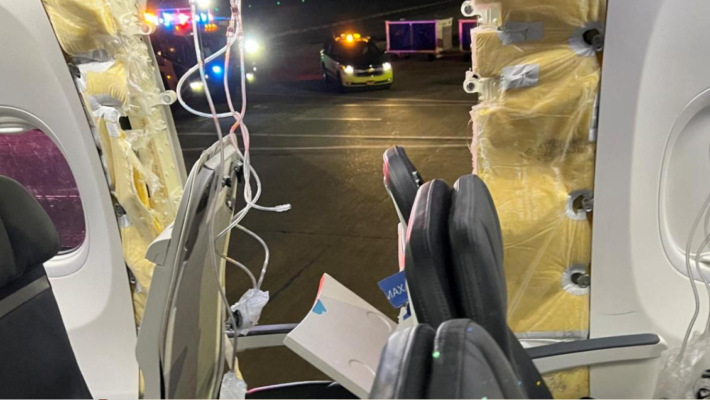Investigating the Alaska Airlines Fuselage Blowout: A Critical Examination of the Incident

The Missing Door Plug: A Key Element in the Investigation
Federal officials, currently examining the horrifying midflight blowout of a section of an Alaska Airlines aircraft’s fuselage, have announced a significant development – the missing piece, a refrigerator-sized Boeing 737 MAX 9 fuselage door plug, has been found. This discovery is a pivotal moment in the investigation into the “explosive decompression” incident that unfolded on Flight 1282 shortly after takeoff from Portland, Oregon. The National Transportation Safety Board (NTSB) Chair, Jennifer Homendy, revealed that a Portland schoolteacher named Bob discovered the door plug in his yard, leading to an immediate outreach to the NTSB.
The Harrowing Ordeal: Exploring the Aftermath Inside the Alaska Airlines Aircraft
The incident, marked by a violent blowout that left a gaping hole in the Alaska Airlines aircraft’s side at 16,000 feet, resulted in a harrowing experience for the 177 people on board. Headrests were ripped off seats, and items were sucked from the cabin, painting a chaotic scene inside the plane. Despite the described explosive event, the exterior inspection of the airframe revealed no structural damage. However, the interior suffered damage to non-critical components, including trim, insulation, windows, and seats. The NTSB is now focused on uncovering the details of this terrifying event, examining the detached door plug and continuing the meticulous examination of the plane’s interior.
Complications in Investigation: Loss of Critical Cockpit Audio Recordings
One of the challenges in the investigation stems from the loss of critical cockpit audio recordings due to a device setting. Homendy highlighted that the cockpit voice recorder, crucial for understanding the communication between the flight crew and attendants during the crisis, was completely overwritten. This loss poses a significant setback, as the audio recording is vital for improving aviation safety. The NTSB chief expressed disappointment over the overwritten recorder and called for a regulatory change requiring all Alaska Airlines aircraft, not just new ones, to extend their cockpit voice recordings to 25 hours.
Previous Warnings: Examining the Plane’s Pressurization Issues
Unanswered questions linger concerning previous warnings about the plane’s pressurization and its connection to the fuselage blowout. The Alaska Airlines aircraft had been restricted from flying over water due to auto pressurization fail lights. The NTSB revealed that the plane’s fail light had come on three times in the month leading up to the incident. While investigators find the repeated pressurization alert disconcerting, they emphasize the need to determine whether it correlates with the catastrophic event. The NTSB plans to scrutinize maintenance records and defects since the aircraft’s delivery on October 31, shedding light on potential safety concerns.
Impact on Alaska Airlines Flight Crew and Passengers: Interviews and Interior Damage Assessment
Interviews with the Alaska Airlines flight crew provide insight into the chaotic scene during and after the explosive event. Flight attendants, facing a forceful depressurization, rushed to secure unaccompanied minors on board, ensuring they wore oxygen masks and lap belts. Despite communication challenges between the pilots and flight attendants, Homendy praised the crew’s heroic actions. The impact of the event caused damage to non-critical components, including interior paneling, trim, and plastic around windows. While the two seats next to the blown-out area were empty, the damage extended to several rows inside the plane.
Cell Phones as Potential Evidence: A Glimpse into the Aftermath
In an unexpected turn, two cell phones likely flung from the plane were found and turned in to investigators. These fallen cell phones, discovered in a yard and on the side of a road, could provide crucial evidence. The NTSB is optimistic about the potential insights these devices may offer into the incident. Fallen cell phones have been valuable in past investigations, helping determine events post-tragedy and guiding investigators to the right areas. This newfound evidence adds another layer to the ongoing examination of the Alaska Airlines fuselage blowout.
Collaborative Efforts: Industry Response and Ongoing Investigation
Read Related Story: DGCA Issues Emergency Directive for Boeing 737-8 Max Planes: Alaska Airlines Incident Sparks Precautionary Inspections
In response to the incident, the supplier of Boeing’s 737 MAX jets, Spirit Aero Systems, expressed gratitude for the crew’s appropriate procedures in landing the airplane safely. The company emphasized its focus on the quality and product integrity of the aircraft structures it delivers. Alaska Airlines, in collaboration with Boeing, is actively working to understand the details of Flight 1282’s incident. As the investigation unfolds, federal officials, along with industry stakeholders, continue their collaborative efforts to determine the root cause of the explosive decompression and prevent such incidents from occurring in the future.
Also Read : Japan Jet Crash: Exemplary Evacuation from Plane Inferno Highlights Crucial Factors
In conclusion, the investigation into the Alaska Airlines fuselage blowout is a multi-faceted effort aimed at unraveling the complexities of the incident. The discovery of the missing door plug and ongoing examination of various elements, including warning lights, interior damage, and potential evidence from fallen cell phones, contribute to a comprehensive understanding of what transpired. While challenges persist, the commitment of federal agencies, industry players, and investigators to uncover the truth underscores the collective dedication to aviation safety.





